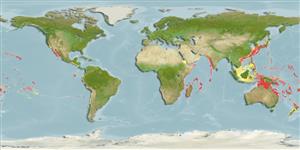Environment: milieu / climate zone / depth range / distribution range
Écologie
marin récifal. Tropical
Western Pacific: Japan to Australia and the Kermadec Islands. Recently reported from Tonga (Ref. 53797).
Taille / Poids / Âge
Maturity: Lm ? range ? - ? cm
Max length : 5.0 cm TL mâle / non sexé; (Ref. 2334)
Rayons mous dorsaux (Total) : 12 - 43; Rayons mous anaux: 22 - 40. Body fully scale. At least some of the dorsal saddles reaching a distinct lateral band. Combined number of soft rays in dorsal and anal fins usually 49 to 55 (Ref 12874).
A cryptic species that occurs on sandy or gravel bottoms. Pointed snout is used for burrowing; eyes directed upwards for sighting prey. Found from shallow tide pools to at least 150 m (Ref. 2334). Eyes move independently and possess a refractive cornea, a convexiclivate fovea and a non-spherical lens (Ref. 50869). Neither cleitheral spine gland nor anterolateral glandural goove with gland is present (Ref. 57406).
Life cycle and mating behavior
Maturities | Reproduction | Spawnings | Egg(s) | Fecundities | Larves
Randall, J.E., G.R. Allen and R.C. Steene, 1990. Fishes of the Great Barrier Reef and Coral Sea. University of Hawaii Press, Honolulu, Hawaii. 506 p. (Ref. 2334)
Statut dans la liste rouge de l'IUCN (Ref. 130435)
Menace pour l'homme
Harmless
Utilisations par l'homme
Pêcheries: sans intérêt
Outils
Articles particuliers
Télécharger en XML
Sources Internet
Estimates based on models
Preferred temperature (Ref.
123201): 18.2 - 28.8, mean 27 °C (based on 664 cells).
Phylogenetic diversity index (Ref.
82804): PD
50 = 0.5156 [Uniqueness, from 0.5 = low to 2.0 = high].
Bayesian length-weight: a=0.00389 (0.00180 - 0.00842), b=3.12 (2.94 - 3.30), in cm total length, based on all LWR estimates for this body shape (Ref.
93245).
Niveau trophique (Ref.
69278): 3.0 ±0.00 se; based on food items.
Fishing Vulnerability (Ref.
59153): Low vulnerability (10 of 100).
Nutrients (Ref.
124155): Calcium = 196 [92, 406] mg/100g; Iron = 0.953 [0.517, 1.781] mg/100g; Protein = 17.8 [16.5, 19.0] %; Omega3 = 0.0915 [, ] g/100g; Selenium = 16.7 [6.6, 42.5] μg/100g; VitaminA = 380 [100, 1,505] μg/100g; Zinc = 2.72 [1.66, 4.19] mg/100g (wet weight);
